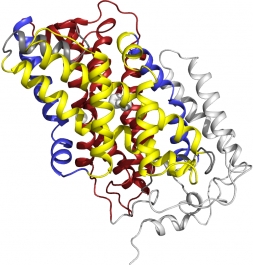UK team reveals all three structures of a single transporter protein

Discovery could help scientists design new drugs - News Release
Adapted from a press release issued by the University of Leeds
Friday 23 April 2010
A team of researchers from Imperial College London and the Universities of Leeds and Oxford has captured the 3D atomic models of a single transporter protein in each of its three main structural states, an achievement that has been a goal of researchers from around the world for over 25 years.
See also:
Related news stories:
The discovery offers remarkable insight into the function of one of the body's most fundamental processes - the movement of essential chemicals into cells of the body - and creates an opportunity to develop brand new drugs.
Biologists have surmised that transporter proteins of this type, which sit in the cell membrane, carry molecules through the otherwise impermeable membrane by shifting between at least three distinct structural states, controlled by ion gradients.
In the first state, there is an outward-facing cavity. A compound will enter this cavity and attach to a binding site whereupon the protein will move to a second state with the cargo locked inside. The third state is formed when the protein opens up a cavity on the inward-facing side to release the compound into the cell. The switch between outward and inward-facing sides works rather like a 'kissing gate' in which the cavity is either on one side or the other but there is never a direct channel through the whole protein.
Until now, scientists had never observed the structural details of these three states in a single protein and theories about how the mechanism worked in detail were based on stitching together their observations from different transporters.
"Previous models gave us a broad understanding of the mechanism involved, but this could never really be usefully applied for drug development," says Professor Peter Henderson of the University of Leeds. "The goal for researchers in this area has always been to observe the entire mechanism in a single protein."
The research, published today in Science, reports the mapping of the inward-facing structure of the bacterial Mhp1 transporter protein, the third structural state that they have determined for this protein. The team has been studying Mhp1 for more than ten years and their observations of the first two structures were published in Science in October 2008.

Structure of the inward-facing form of Mhp1. The grey-shaded 'ghost' positions are indicated of a sodium ion as a sphere and benzylhydantoin as a small molecule
The protein was produced in Leeds; the structures were determined by X-ray crystallography and analysed at Imperial College London and the Imperial College Membrane Protein Laboratory (MPL) located at Diamond Light Source. Oxford University carried out dynamic molecular simulations to investigate further the transitions between the three states of the protein.
"This third structure completes the picture and we can now understand Mhp1's 'alternating access' mechanism in great detail," said Dr Alexander Cameron, from the Division of Molecular Biosciences at Imperial College London. "We also unexpectedly found that the structures are similar across many transporter proteins previously thought to be different, so we're expecting our model to help achieve some rapid progress in the research of colleagues around the world."
The detailed knowledge of the mechanism could unlock new drug developments in several ways, says Professor Henderson. "Altering the delivery of compounds into a cell is one potential benefit for treating illness. For example this could be useful in treating conditions where certain chemicals are lacking and need boosting permanently - such as serotonin for those suffering from depression and glucose for those with diabetes."
Funded by the Biotechnology and Biological Sciences Research Council (BBSRC), the EU, the Japanese Science and Technology Agency and the Wellcome Trust, the research team comprises: Professor Henderson and colleagues from Leeds, who expressed and purified the Mhp1 protein; Professor So Iwata, Dr Alex Cameron and colleagues from Imperial College London and the MPL who imaged the crystals and combined all the information to propose a mechanism for the alternating access model; and Professor Mark Sansom and Dr Oliver Beckstein from the University of Oxford who authenticated the plausibility of the transitions between the three states.
-Ends-
For further information please contact:
Clare Elsley, Campuspr Ltd
Tel 44 (0) 113 258 9880
Mobile 44 (0) 7767 685168
Article text (excluding photos or graphics) © Imperial College London.
Photos and graphics subject to third party copyright used with permission or © Imperial College London.
Reporter
Press Office
Communications and Public Affairs
- Email: press.office@imperial.ac.uk
